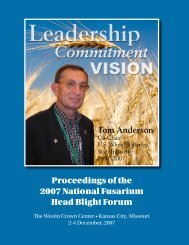uniform southern soft red winter wheat fusarium head blight ...
uniform southern soft red winter wheat fusarium head blight ...
uniform southern soft red winter wheat fusarium head blight ...
You also want an ePaper? Increase the reach of your titles
YUMPU automatically turns print PDFs into web optimized ePapers that Google loves.
UNIFORM SOUTHERN SOFT RED WINTER WHEAT FUSARIUM HEAD BLIGHT SCREENING<br />
NURSERY<br />
2000 NURSERY REPORT<br />
Coordinated by:<br />
Paul Murphy<br />
Rene Navarro<br />
Goran Srnic<br />
This is a joint progress report of cooperative investigations underway and funded by the State Agricultural Experiment<br />
Stations, private companies and the United States Department of Agriculture, Agricultural Research Service. This report<br />
contains preliminary data that have not been sufficiently confirmed to justify general release; interpretations may be modified<br />
with additional experimentation. Confirmed results will be published through established channels. The report is a tool for the<br />
use of the cooperators and their official staff and those persons having direct interest in the development of agricultural<br />
research programs.<br />
This report is not intended for publication and should not be refer<strong>red</strong> to in literature citations or quoted in publicity or<br />
advertising. Use of the data may be granted for certain purposes upon written request to the agency or agencies involved.<br />
North Carolina State University<br />
Department of Crop Science<br />
Box 7629<br />
Raleigh, NC 27695-7629<br />
December 1, 2000
TABLE OF CONTENTS<br />
Location Notes ................................................................................................................................. 1,2<br />
List of Entries and Pedigrees......................................................................................................... 3<br />
Heading Date ................................................................................................................................... 4<br />
FHB Incidence.................................................................................................................................. 5<br />
FHB Severity..................................................................................................................................... 6<br />
FHB Index.......................................................................................................................................... 7<br />
FHB Kernel Quality/Rating .............................................................................................................. 8<br />
Scabby Seed.................................................................................................................................... 9<br />
Vomitoxin (DON).............................................................................................................................. 10<br />
Greenhouse Screening Data (Type 2)........................................................................................... 11<br />
Plant Height....................................................................................................................................... 12<br />
Means Across Locations................................................................................................................. 13<br />
Correlations Between Traits ........................................................................................................... 14
LOCATION NOTES<br />
Bay, Arkansas<br />
• Cooperators: June Hancock, David Hill, Luis LazoAnaya<br />
Novartis Seeds Inc.<br />
• Reps: 3 Plot size: 4 rows by 3 feet Seed date: October 26, 1999<br />
• Inoculation method: Corn kernels twice (3/27/00 and 4/14/00)<br />
• Precipitation during grain fill: Sprinkler daily<br />
• Avg temp. during grain fill: 70’s<br />
• Date/Feekes growth stage when sco<strong>red</strong>: Ratings taken 21 days after last inoculation<br />
Urbana, Illinois<br />
• Cooperators: F<strong>red</strong> Kolb, Larry Boze<br />
University of Illinois<br />
• Reps: 2 Plot size: Single 3’ row Seed date: October 6, 1999<br />
• Inoculation method: Grain spawn-infected <strong>wheat</strong> seed<br />
• Precipitation during grain fill: Natural + mist irrigation, 6-7:30 AM and 7:30-9 PM (0.36”/day)<br />
• Avg temp. during grain fill: Mod. cool, 70’s and 80’s<br />
Wooster, Ohio<br />
• Cooperators: Pat Lipps, Larry Herald, Audrey Johnston, Jessica Engle, Anju Gupta<br />
Ohio State University<br />
• Reps: 3 Plot size: 1-m long row Seed date: October 5, 1999 Harvest date: July 10-15, 2000<br />
• Inoculation method: Infested corn kernels spread throughout plot<br />
• Precipitation during grain fill: Mist irrigation supplied each day 6-9 AM and 8-10 PM during flower<br />
• Avg temp. during grain fill: 69.1 F<br />
• Date/Feekes growth stage when sco<strong>red</strong>: 11.2<br />
Lexington, Kentucky<br />
• Cooperators: Dave Van Sanford, Brenda Kennedy, Maria Hall<br />
University of Kentucky<br />
• Plot size: Four-row plot, 4’ by 4”<br />
• Inoculation method: Plots were inoculated using the scabby corn seed method on April 24<br />
• Precipitation during grain fill: Over<strong>head</strong> misting system used intermittently during 6-10 AM and 8-10 PM
Blacksburg, Virginia<br />
• Cooperators: Carl A. Griffey, Jianli Chen<br />
Virginia Tech<br />
• Field design: Randomized complete block Reps: 3 Plot size: 4 x 5 ft 2<br />
• Inoculation method: Spraying conidial suspension (5 x 10 4 spores/ml) used in field tests and floret inoculation (5 x 104 spores/ml) was<br />
applied in greenhouse tests; plots inoculated 3 times when 50%, 100% of <strong>head</strong>s were <strong>head</strong>ing and 50% of <strong>head</strong>s were beginning to<br />
flower<br />
• Data collection: 50 <strong>head</strong>s from each plot rated for incidence and severity at 21 and 28 days after inoculation; scabby seed handcounted<br />
based on 200 kernels of each plot; severity for greenhouse test was 21 days rating<br />
Kinston, North Carolina<br />
• Cooperators: Rene Navarro, Goran Srnic, Paul Murphy<br />
North Carolina State University<br />
• Reps: 3 Plot size: 4 rows x 4’ Seed date: October 29, 1999<br />
• Inoculation method: Field: Colonized corn kernels applied twice (early and mid-boot stages) at a rate of 2 g/sq ft. Mist irrigation daily<br />
8-10 AM and 4-6 PM. Greenhouse: Mix of five isolates, 50,000 conidia/ml. 10 µl of inoculum applied to central floret. Transfer<strong>red</strong> to<br />
humity chamber for 72 hr. Symptoms read 21 days post-inoculation.<br />
• Date/Feekes growth stage when sco<strong>red</strong>: Approximately 28 days after <strong>head</strong>ing.<br />
Griffin, Georgia<br />
• Cooperator: Jerry Johnson<br />
University of Georgia<br />
• No data to report--Negligible FHB<br />
Baton Rouge, Louisiana<br />
• Cooperator: Steve Harrison<br />
Louisiana State University<br />
• No data to report--Negligible FHB<br />
Clemson, South Carolina<br />
• Cooperator: Doyce Graham<br />
Clemson University<br />
• No data to report--Negligible FHB














